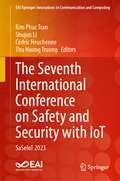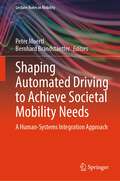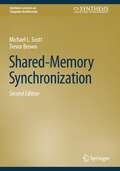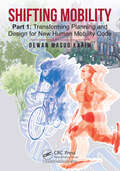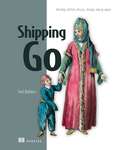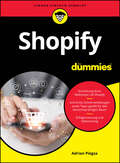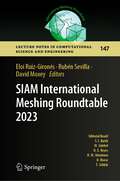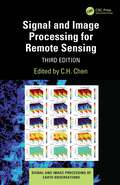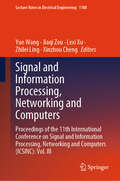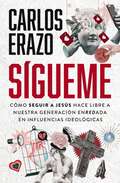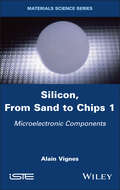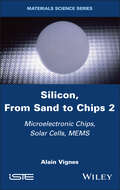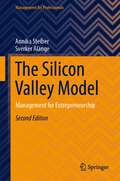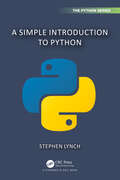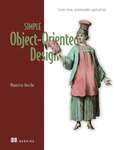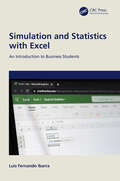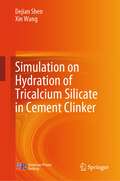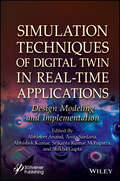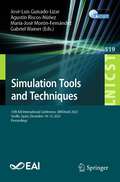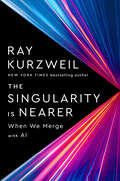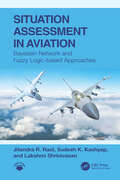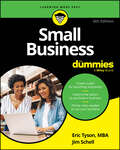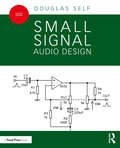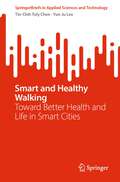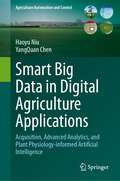- Table View
- List View
The Seventh International Conference on Safety and Security with IoT: SaSeIoT 2023 (EAI/Springer Innovations in Communication and Computing)
by Kim Phuc Tran Shujun Li Cédric Heuchenne Thu Huong TruongThis book presents the Fifth International Conference on Safety and Security with IoT (SaSeIoT 2023), which took place Bratislava, Slovakia, October 24-26, 2023. The conference aims to explore not only IoT and its related critical applications but also IoT towards Security and Safety. The conference solicits original and inspiring research contributions from experts, researchers, designers, and practitioners in academia, industry and related fields and provides a common platform to share knowledge, experience and best practices in various domains of IoT.
Shaping Automated Driving to Achieve Societal Mobility Needs: A Human-Systems Integration Approach (Lecture Notes in Mobility)
by Peter Moertl Bernhard BrandstaetterThis edited book describes novel human-systems integration approaches to improve acceptance, safety, and comfort of automated vehicles. Each chapter analyses different aspects in the development of automated driving systems such as: assessing needs and opportunities of specific user populations i.e. elderly drivers and truck drivers; creating fluid human-systems interactions in the vehicle to answer specific driver needs; developing an automated driving tutoring application; and identifying benefits of including road infrastructure sensors to support automated driving predictability. A detailed description of the assessment of the above-described solutions in real-world situations is also included. Written by both researchers and professionals, this book offers timely and practice-oriented information concerning the development of automated driving systems that better adapt to the users’ needs.
Shared-Memory Synchronization (Synthesis Lectures on Computer Architecture)
by Michael L. Scott Trevor BrownThis book offers a comprehensive survey of shared-memory synchronization, with an emphasis on “systems-level” issues. It includes sufficient coverage of architectural details to understand correctness and performance on modern multicore machines, and sufficient coverage of higher-level issues to understand how synchronization is embedded in modern programming languages.The primary intended audience for this book is “systems programmers”—the authors of operating systems, library packages, language run-time systems, concurrent data structures, and server and utility programs. Much of the discussion should also be of interest to application programmers who want to make good use of the synchronization mechanisms available to them, and to computer architects who want to understand the ramifications of their design decisions on systems-level code.
Shifting Mobility: Part 1: Transforming Planning and Design for New Human Mobility Code
by Dewan Masud KarimIn the face of resource depletion, environmental changes, lifestyle changes, demographic and digital adaptation, old ideologies of city building and expensive and complex automobility solutions are in freefall. These changes are creating severe friction between the old and new paradigms. This book provides new perspectives through the process of ideological disassociation and concepts of human mobility code. The basic premise of the book, human mobility is an essential component of our creativity that comes from our unconscious desire to become a part of a community. Several new concepts in the book starts with the hallmark of new discovery of human mobility code and its implications of urban mobility boundary systems to stay within safe planetary zone. A new discovery of human mobility code from comprehensive research finding prove that each individual develops a unique mobility footprint and become our mobility identity. Beyond individual hallmarks, human develops collective mobility codes through interaction with the third space on which entire mobility systems lie and are created by the fundamentals of city planning and the design process. Readers are introduced to an innovative mobility planning process and reinvention of multimodal mobility approaches based on new mobility code while formulating new concepts, practical solutions and implementation techniques, tools, policies, and processes to reinforce low-carbon mobility options while addressing social equity, environmental, and health benefits. Finally, the book arms us with knowledge to prevent the disaster of full technological enlightenment against our natural human mobility code.
Shipping Go: Develop, deliver, discuss, design, and go again
by Joel HolmesBuild and upgrade an automated software delivery pipeline that supports containerization, integration testing, semantic versioning, automated deployment, and more.In Shipping Go you will learn how to: Develop better software based on feedback from customers Create a development pipeline that turns feedback into features Reduce bugs with pipeline automation that validates code before it is deployed Establish continuous testing for exceptional code quality Serverless, container-based, and server-based deployments Scale your deployment in a cost-effective way Deliver a culture of continuous improvement Shipping Go is a hands-on guide to shipping Go-based software. Author Joel Holmes shows you the easy way to set up development pipelines, fully illustrated with practical examples in the powerful Go language. You&’ll put continuous delivery and continuous integration into action, and discover instantly useful guidance on automating your team&’s build and reacting with agility to customer demands. Your new pipelines will ferry your projects through production and deployment, and also improve your testing, code quality, and production applications. Purchase of the print book includes a free eBook in PDF, Kindle, and ePub formats from Manning Publications. About the Technology An effective software delivery pipeline automates all stages, from initial design, through development, deployment, and ultimately the usage experience that feeds back into new features and releases. Go embraces the best practices of Continuous Delivery, and adds a few language-specific tools and twists of its own. About the Book Shipping Go shows you how to build Go-specific software development pipelines. You&’ll have a basic CI/CD process up and running by the time you finish Chapter 3, along with an iterative process for designing, releasing, and revising your applications. Then, you&’ll systematically upgrade your pipeline to support containerization, integration testing, semantic versioning, and automated deployment. A set of handy appendices help you translate these valuable practices to Kotlin, Python, and JavaScript applications. What&’s Inside Create a development pipeline that turns feedback into features Automatically validate code before it is deployed Serverless, container-based, and server-based deployments Scale your deployment in a cost-effective way About the Reader For Go developers. About the Author Joel Holmes builds cloud native applications, helping to architect, design, and develop them. A Golang tech lead, Aliénor Latour was the technical editor for this book. Table of Contents PART 1 - STARTUP 1 Delivering value 2 Introducing continuous integration 3 Introducing continuous testing 4 Introducing continuous deployment PART 2 - SCALING 5 Code quality enforcement 6 Testing frameworks, mocking, and dependencies 7 Containerized deployment PART 3 - GOING PUBLIC 8 Configuration management and stable releases 9 Integration testing 10 Advanced deployment 11 The loop
Shopify für Dummies (Für Dummies)
by Adrian PiegsaIn kürzester Zeit erfolgreich auf Shopify Mit Shopify bauen Sie Ihren eigenen Online-Shop, der perfekt zu Ihren Bedürfnissen passt. Adrian Piegsa gibt Ihnen einen Überblick über die Shop-Plattform, zeigt Ihnen, wie Sie sich zurechtfinden und worauf Sie achten müssen. Sie lernen Schritt für Schritt, wie Sie Ihren Webshop mit Kategorien und Produkten anlegen, Bestellungen abwickeln und Ihren Erfolg optimieren. Darüber hinaus erfahren Sie alles über Vertriebs- und Werbemöglichkeiten von Shopify und erhalten Tipps und Tricks im Umgang mit der Software ? speziell für den deutschsprachigen Raum. Sie erfahren Wie Sie sich auf Shopify zurechtfinden Was eine gute Shop-Struktur ausmacht Wie Sie Shopify-Apps sinnvoll nutzen Wie Sie Ihre Statistiken einsehen und auswerten
SIAM International Meshing Roundtable 2023 (Lecture Notes in Computational Science and Engineering #147)
by Eloi Ruiz-Gironés Rubén Sevilla David MoxeyThis volume comprises selected papers from the SIAM International Meshing Roundtable Workshop 2023, SIAM IMR 2023, held in Amsterdam, the Netherlands, March 6-9, 2023. The IMR was started by Sandia National Laboratories in 1992 and, since 2021, it has been held under the umbrella of the Society for Industrial and Applied Mathematics (SIAM). The SIAM IMR 2023 was the first in-situ conference to be held since 2019, after two online conferences. It consisted of short courses, technical presentations from keynotes, contributed talks and research notes, a poster session and meshing contest, and discussion panels. The papers in these proceedings present novel contributions that range from theoretical advances to technical applications in engineering, geometric modeling, computer graphics, visualization, and machine learning.
Signal and Image Processing for Remote Sensing (ISSN)
by C. H. ChenAdvances in signal and image processing for remote sensing have been tremendous in recent years. The progress has been particularly significant with the use of deep learning based techniques to solve remote sensing problems. These advancements are the focus of this third edition of Signal and Image Processing for Remote Sensing. It emphasizes the use of machine learning approaches for the extraction of remote sensing information. Other topics include change detection in remote sensing and compressed sensing. With 19 new chapters written by world leaders in the field, this book provides an authoritative examination and offers a unique point of view on signal and image processing.Features Includes all new content and does not replace the previous edition Covers machine learning approaches in both signal and image processing for remote sensing Studies deep learning methods for remote sensing information extraction that is found in other books Explains SAR, microwave, seismic, GPR, and hyperspectral sensors and all sensors considered Discusses improved pattern classification approaches and compressed sensing approaches Provides ample examples of each aspect of both signal and image processing This book is intended for university academics, researchers, postgraduate students, industry, and government professionals who use remote sensing and its applications.
Signal and Information Processing, Networking and Computers: Proceedings of the 11th International Conference on Signal and Information Processing, Networking and Computers (ICSINC): Vol. III (Lecture Notes in Electrical Engineering #1188)
by Yue Wang Lexi Xu Jiaqi Zou Zhilei Ling Xinzhou ChengThis book collects selected papers from the 11th Conference on Signal and Information Processing, Networking and Computers held in Chengdu, China, in September 2023. The book focuses on the current works of information theory, communication system, computer science, aerospace technologies, big data, and other related technologies. People from both academia and industry of these fields can contribute and find their interests from the book.The 11th International Conference on Signal and Information Processing, Networking and Computers (ICSINC) was held in Chengdu, China, in September 2023, which focused on the key technologies and challenges of signal and information processing schemes, network application, computer theory, space technologies, big data, and other related technologies
Sígueme: Cómo seguir a Jesús hace libre a nuestra generación enredada en influencias ideológicas
by Carlos ErazoEn Sígueme, el pastor y autor Carlos Erazo nos explica cómo nos hemos convertido en la generación con los niveles más altos de ansiedad, preocupación, estrés, depresión, incertidumbre y temor en la historia porque seguimos al guía equivocado.En vez de enseñarle al corazón a seguir a Jesús, hemos permitido que alguien le enseñe a nuestro corazón a seguir otras influencias, otras tendencias, otras ideologías. Pero no es demasiado tarde para darle un nuevo destino al corazón comenzando hoy como aprendices de Jesús.En el nuevo libro de Carlos Erazo, Sígueme, el autor revela cómo estas plataformas influyen en nuestras vidas más de lo que creemos, abordando temas como:La adicción a las redes socialesEl consumo desenfrenado de pornografíaLa escalada de problemas de salud mental como la ansiedad y la depresiónLa obsesión por uno mismo y la caída en picado de la autoestimaA través de una mirada profunda a las Escrituras, descubriremos que Jesús nos ofrece una vida libre de todo aquello que te tiene enredado, atrapado o atascado. Para que cuando otros vean tu vida, comprendan que la única explicación de una vida tan radicalmente diferente a la de la mayoría es porque está marcada por la devoción a Jesús.Follow MeIn Follow Me, pastor and author Carlos Erazo explains how we have become the generation with the highest levels of anxiety, worry, stress, depression, uncertainty and fear in history because we follow the wrong guide.Instead of teaching our hearts to follow Jesus, we have allowed someone else to teach our hearts to follow other influences, other trends, other ideologies. But it is not too late to give a new destiny to the heart starting today as apprentices of Jesus.In Carlos Erazo's new book, Follow Me, the author reveals how these platforms influence our lives more than we think, addressing topics such as:The addiction to social mediaThe rampant consumption of pornographyThe escalation of mental health problems such as anxiety and depressionSelf-obsession and plummeting self-esteemThrough a deep look at Scripture, we will discover that Jesus offers us a life free of anything that has you entangled, trapped or stuck. So that when others see your life, they will understand that the only explanation for a life so radically different from most is because it is marked by devotion to Jesus.
Silicon, From Sand to Chips, Volume 1: Microelectronic Components
by Alain VignesSilicon is the material of the digital revolution, of solar energy and of digital photography, which has revolutionized both astronomy and medical imaging. It is also the material of microelectromechanical systems (MEMS), indispensable components of smart objects. The discovery of the electronic and optoelectronic properties of germanium and silicon during the Second World War, followed by the invention of the transistor, ushered in the digital age. Although the first transistors were made from germanium, silicon eventually became the preferred material for these technologies. Silicon, From Sand to Chips 1 traces the history of the discoveries, inventions and developments in basic components and chips that these two materials enabled one after the other. The book is divided into two volumes and this first volume is devoted to basic microelectronic components.
Silicon, From Sand to Chips, Volume 2: Microelectronic Chips, Solar Cells, MEMS
by Alain VignesSilicon is the material of the digital revolution, of solar energy and of digital photography, which has revolutionized both astronomy and medical imaging. It is also the material of microelectromechanical systems (MEMS), indispensable components of smart objects. The discovery of the electronic and optoelectronic properties of germanium and silicon during the Second World War, followed by the invention of the transistor, ushered in the digital age. Although the first transistors were made from germanium, silicon eventually became the preferred material for these technologies. Silicon, From Sand to Chips 2 traces the history of the discoveries, inventions and developments in basic components and chips that these two materials enabled one after the other. The book is divided into two volumes and this second volume is devoted to microelectronic and optoelectronic chips, solar cells and MEMS.
The Silicon Valley Model: Management for Entrepreneurship (Management for Professionals)
by Annika Steiber Sverker AlängeThe first edition of The Silicon Valley Model, published in 2016, addresses the need for a fundamentally new approach to managing and developing large firms with an emphasis on entrepreneurship. This second edition validates, extends, and updates these original findings. While still encompassing the observations and analysis featured in the first edition, this new edition addresses new developments in management and in the global business environment. Further, it presents Dr. Steiber’s research identifying more companies in Asia, Europe, and the USA that are implementing management approaches that parallels the Silicon Valley Model, and in some respects, advanced upon it. New material, appearing mainly in the “Recent Developments” sections in each chapter, includes both real-life events and new research findings related to the management principles for entrepreneurship. In some cases, elements of innovation and development of the Silicon Valley Model have taken new forms in response to changing times or the desires of the companies involved. The Silicon Valley Model, Second Edition is beneficial to executives from the board and CEO level on down, consultants, researchers, and others who study or work with new developments in management.
A Simple Introduction to Python (Chapman & Hall/CRC The Python Series)
by Stephen LynchA Simple Introduction to Python is aimed at pre-university students and complete novices to programming. The whole book has been created using Jupyter notebooks. After introducing Python as a powerful calculator, simple programming constructs are covered, and the NumPy, MatPlotLib and SymPy modules (libraries) are introduced. Python is then used for Mathematics, Cryptography, Artificial Intelligence, Data Science and Object Oriented Programming.The reader is shown how to program using the integrated development environments: Python IDLE, Spyder, Jupyter notebooks, and through cloud computing with Google Colab.Features: No prior experience in programming is required. Demonstrates how to format Jupyter notebooks for publication on the Web. Full solutions to exercises are available as a Jupyter notebook on the Web. All Jupyter notebook solution files can be downloaded through GitHub. GitHub Repository of Data Files and a Jupyter Solution notebook: https://github.com/proflynch/A-Simple-Introduction-to-PythonJupyter Solution notebook web page: https://drstephenlynch.github.io/webpages/A-Simple-Introduction-to-Python-Solutions.html
Simple Object-Oriented Design: Create clean, maintainable applications
by Mauricio AnicheWrite object-oriented code that&’s manageable, maintainable, and future-proof.Keeping your object-oriented designs simple demands a creative approach—and that&’s exactly what you&’ll find in Simple Object-Oriented Design. This book is full of patterns and principles for reducing complexity, each one proven in author Mauricio Aniche&’s 20-year career in software development. You&’ll learn how to tackle code&’s natural growth in complexity, and adopt a &“good enough&” approach that means it&’s easy to refactor when requirements change. You&’ll discover insightful principles for: Making code readable and documented Improving consistency and encapsulation Managing dependencies Designing abstractions Handling infrastructure Effective modularization Learn what constitutes both good and bad object-oriented software design, discover how to make better trade-offs in design decisions, and when to embrace complexity over simpler data structures. With this book as your vital reference, you&’ll be ready to write code that will last the test of time, without slowing feature delivery to a crawl. About the technology Even a simple object-oriented application can quickly become complex as it evolves. Each new class, method, or feature means more state and abstractions to manage, which in turn increases complexity, maintenance, and time spent detangling legacy code. It takes effort and skill to keep your codebase simple. This book shows you how. About the book Simple Object-Oriented Design: Create clean, maintainable applications presents practical design principles you can use to keep an object-oriented codebase simple as it grows and changes. Written as a collection of practical techniques you can apply in any OO language, it offers tips for concise code, managing dependencies and modules, and designing flexible abstractions. Illuminating figures, real-world examples, and insightful exercises make each principle stick. What's inside Writing simple, understandable classes Flexible abstractions to extend your designs Reducing the impact of coupling About the reader Readers should be familiar with an object-oriented language like Java, C#, or Python. About the author Maurício Aniche is a software engineer with 20 years of experience. He&’s also an Assistant Professor in Software Engineering at Delft University of Technology, and the author of Effective Software Testing. Table of Contents 1 It&’s all about managing complexity 2 Making code small 3 Keeping objects consistent 4 Managing dependencies 5 Designing good abstractions 6 Handling external dependencies and infrastructure 7 Achieving modularization 8 Being pragmatic
Simulation and Statistics with Excel: An Introduction to Business Students
by Luis Fernando IbarraThe use of simulation techniques has increased in importance in recent history, and simulation activities are an important resource for advanced preparation for the organization and execution of events. When formal mathematics is not enough, simulation may be the only option capable of approximating solutions. Simulation and Statistics with Excel: An Introduction to Business Students offers a non-rigorous and practical tour of the simulation procedure on computers, using a versatile and accessible resource, the Microsoft Excel spreadsheet. This book covers the concepts essential to understanding the basic principles and approaches of statistical simulation, allowing for the study of complex systems. Aimed at students in business and operational research beginning to use simulation as an instrument for understanding existing or proposed processes, this book will lay solid foundations in understanding simulation experimentation.Key Features: Provides a basis to understand the approaches and principles of simulator experiments. Uses a universal and easily accessible resource. Introduces simple examples to teach the fundamentals of simulation.
Simulation on Hydration of Tricalcium Silicate in Cement Clinker
by Dejian Shen Xin WangThis book is written based on authors' research on cement hydration during the past decade. It establishes simulation model to evaluate the influence of crystal defects on the dissolution of tricalcium silicate and morphology change of particles and explores the hydration kinetics and microstructure development of tricalcium silicate under the mixed control of dissolution, diffusion, as well as boundary nucleation and growth. It also provides a theoretical basis for regulating the microstructure and performance of cement-based materials. It is designed as a reference work for professionals or practitioners and as a textbook for undergraduates or postgraduates. This book provides valuable knowledge and useful methods that can be applied in the field of cement hydration.
Simulation Techniques of Digital Twin in Real-Time Applications: Design Modeling and Implementation
by Abhishek Kumar Shikha Gupta Abhineet Anand Anita Sardana Srikanta Kumar MohapatraSIMULATION TECHNIQUES OF DIGITAL TWIN IN REAL-TIME APPLICATIONS The book gives a complete overview of implementing digital twin technology in real-time scenarios while emphasizing how this technology can be embedded with running technologies to solve all other issues. Divided into two parts with Part 1 focusing on simulated techniques in digital twin technology and Part 2 on real-time applications of digital twin technology, the book collects a significant number of important research articles from domain-specific experts. The book sheds light on the various techniques of digital twin technology that are implemented in various application areas. It emphasizes error findings and respective solutions before the actual event happens. Most of the features in the book are on the implementation of strategies in real-time applications. Various real-life experiences are taken to show the proper implementation of simulation technologies. The book shows how engineers of any technology can input their research ideas to convert to real scenarios by using replicas. Hence, the book has a collection of research articles from various engineers with expertise in different technologies from many regions of the world. It shows how to implement the embedded real-time data into technologies. Specifically, the chapters relate to the auto landing and cruising features in aerial vehicles, automated coal mining simulation strategy, the enhancement of workshop equipment, and implementation in power energy management for urban railways. This book also describes the coherent mechanism of digital twin technologies with deep neural networks and artificial intelligence. Audience Researchers, engineers, and students in computer science, software engineering and industrial engineering, will find this book to be very useful.
Simulation Tools and Techniques: 15th EAI International Conference, SIMUtools 2023, Seville, Spain, December 14-15, 2023, Proceedings (Lecture Notes of the Institute for Computer Sciences, Social Informatics and Telecommunications Engineering #519)
by Agustín Riscos-Núñez José-Luis Guisado-Lizar María-José Morón-Fernández Gabriel WainerThis proceedings constitutes the refereed post-conference proceedings of the 15th International Conference on Simulation Tools and Techniques, SIMUTools 2023, held in Seville, Spain, in December 2023. The 23 revised full papers were carefully selected from 58 submissions. The papers focus on various areas such as Simulation Tools and Methods; Artificial Intelligence and Simulation; Transportation and Logistics; Medical Sciences; and Network Simulations.
The Singularity Is Nearer: When We Merge with AI
by Ray KurzweilThe noted inventor and futurist&’s successor to his landmark book The Singularity Is Near explores how technology will transform the human race in the decades to comeSince it was first published in 2005, Ray Kurzweil&’s The Singularity Is Near and its vision of an exponential future have spawned a worldwide movement. Kurzweil's predictions about technological advancements have largely come true, with concepts like AI, intelligent machines, and biotechnology now widely familiar to the public.In this entirely new book Ray Kurzweil brings a fresh perspective to advances toward the Singularity—assessing his 1999 prediction that AI will reach human level intelligence by 2029 and examining the exponential growth of technology—that, in the near future, will expand human intelligence a millionfold and change human life forever. Among the topics he discusses are rebuilding the world, atom by atom with devices like nanobots; radical life extension beyond the current age limit of 120; reinventing intelligence by connecting our brains to the cloud; how exponential technologies are propelling innovation forward in all industries and improving all aspects of our well-being such as declining poverty and violence; and the growth of renewable energy and 3-D printing. He also considers the potential perils of biotechnology, nanotechnology, and artificial intelligence, including such topics of current controversy as how AI will impact employment and the safety of autonomous cars, and "After Life" technology, which aims to virtually revive deceased individuals through a combination of their data and DNA.The culmination of six decades of research on artificial intelligence, The Singularity Is Nearer is Ray Kurzweil&’s crowning contribution to the story of this science and the revolution that is to come.
Situation Assessment in Aviation: Bayesian Network and Fuzzy Logic-based Approaches
by Jitendra R. Raol Sudesh K. Kashyap Lakshmi ShrinivasanSituation Assessment in Aviation focuses on new aspects of soft computing technologies for the evaluation and assessment of situations in aviation scenarios. It considers technologies emerging from multisensory data fusion (MSDF), Bayesian networks (BN), and fuzzy logic (FL) to assist pilots in their decision-making.Studying MSDF, BN, and FL from the perspective of their applications to the problem of situation assessment, the book discusses the development of certain soft technologies that can be further used for devising more sophisticated technologies for a pilot's decision-making when performing certain tasks: airplane monitoring, pair formation, attack, and threat. It explains the concepts of situation awareness, data fusion, decision fusion, Bayesian networks, fuzzy logic type 1, and interval type 2 fuzzy logic. The book also presents a hybrid technique by using BN and FL and a unique approach to the problem of situation assessment, beyond visual range and air-to-air combat, by utilizing building blocks of artificial intelligence (AI) for the future development of more advanced automated systems, especially using commercial software.The book is intended for aerospace R&D engineers, systems engineers, aeronautical engineers, and aviation training professionals. It will also be useful for aerospace and electrical engineering students taking courses in Air Traffic Management, Aviation Management, Aviation Operations, and Aviation Safety Systems.
Small Business For Dummies
by Eric Tyson Jim SchellEasy-to-follow advice on launching, managing, and growing your business, and making it pay off Small Business For Dummies is the essential guide you need to owning and operating a small business. You’re ready to add your name to the roster of business owners, and this book is here to give you the advice you’ll need at all stages of the game. Start off with insight on preparing to launch a small business, including picking the right business to pursue and getting all the paperwork in order. If you want to purchase an existing business, this book also has you covered. Plus, you’ll learn how to wear all the hats a small business owner must wear, including being your own HR manager, accountant, and marketer—and to make it all work. Create a business plan and learn how to fund your business idea Tackle the basics of small business bookkeeping so you can budget for success Explore the idea of purchasing a business, and hire excellent employees Avoid the most common mistakes that first-time business owners makeThis jargon-free book meets small business owners wherever they are on the road to business success. Small Business For Dummies is great for those just toying with the idea of opening a business, and for those who already call themselves “boss” but need a few extra pointers on making things run smoothly.
Small Signal Audio Design
by Douglas SelfSmall Signal Audio Design is a highly practical handbook providing an extensive repertoire of circuits that can be assembled to make almost any type of audio system. This fully revised fourth edition offers wholly new content on internally balanced audio design, electret microphones, emitter-follower stability, microphony in capacitors, and much, much more. This book continues the engaging prose style familiar to readers as you learn why mercury-filled cables are not a good idea, the pitfalls of plating gold on copper, and what quotes from Star Trek have to do with PCB design. Learn how to: make amplifiers with apparently impossibly low noise design discrete circuitry that can handle enormous signals with vanishingly low distortion transform the performance of low-cost opamps build active filters with very low noise and distortion while saving money on expensive capacitors make incredibly accurate volume controls make a huge variety of audio equalisers use load synthesis to make magnetic cartridge preamplifiers that have noise so low it is limited by basic physics sum, switch, clip, compress, and route audio signals build simple but ultra-low noise power supplies be confident that phase perception is not an issue. Including all the crucial theories, but with minimal mathematics, Small Signal Audio Design is the must-have companion for anyone studying, researching, or working in audio engineering and audio electronics.
Smart and Healthy Walking: Toward Better Health and Life in Smart Cities (SpringerBriefs in Applied Sciences and Technology)
by Tin-Chih Toly Chen Yun-Ju LeeThis book examines smart technologies and their invaluable role in augmenting the walking experience of mobile users. From meticulously planned walking routes to precise footprint detection and analysis, as well as cutting-edge fall detection and prevention mechanisms, these intelligent technologies have the potential to revolutionize healthy and smart walking. Against the backdrop of the post-COVID-19 era, where unrestricted mobility has become pivotal for restoring normalcy, the demand for smart healthcare solutions has soared. The book explores latest advances in sensor technology, cloud computing, deep learning, and networking and related innovative applications that can leverage smart technologies to enhance healthy walking.
Smart Big Data in Digital Agriculture Applications: Acquisition, Advanced Analytics, and Plant Physiology-informed Artificial Intelligence (Agriculture Automation and Control)
by Haoyu Niu YangQuan ChenIn the dynamic realm of digital agriculture, the integration of big data acquisition platforms has sparked both curiosity and enthusiasm among researchers and agricultural practitioners. This book embarks on a journey to explore the intersection of artificial intelligence and agriculture, focusing on small-unmanned aerial vehicles (UAVs), unmanned ground vehicles (UGVs), edge-AI sensors and the profound impact they have on digital agriculture, particularly in the context of heterogeneous crops, such as walnuts, pomegranates, cotton, etc. For example, lightweight sensors mounted on UAVs, including multispectral and thermal infrared cameras, serve as invaluable tools for capturing high-resolution images. Their enhanced temporal and spatial resolutions, coupled with cost effectiveness and near-real-time data acquisition, position UAVs as an optimal platform for mapping and monitoring crop variability in vast expanses. This combination of data acquisition platforms and advanced analytics generates substantial datasets, necessitating a deep understanding of fractional-order thinking, which is imperative due to the inherent “complexity” and consequent variability within the agricultural process. Much optimism is vested in the field of artificial intelligence, such as machine learning (ML) and computer vision (CV), where the efficient utilization of big data to make it “smart” is of paramount importance in agricultural research. Central to this learning process lies the intricate relationship between plant physiology and optimization methods. The key to the learning process is the plant physiology and optimization method. Crafting an efficient optimization method raises three pivotal questions: 1.) What represents the best approach to optimization? 2.) How can we achieve a more optimal optimization? 3.) Is it possible to demand “more optimal machine learning,” exemplified by deep learning, while minimizing the need for extensive labeled data for digital agriculture? This book details the foundations of the plant physiology-informed machine learning (PPIML) and the principle of tail matching (POTM) framework. It is the 9th title of the "Agriculture Automation and Control" book series published by Springer.
